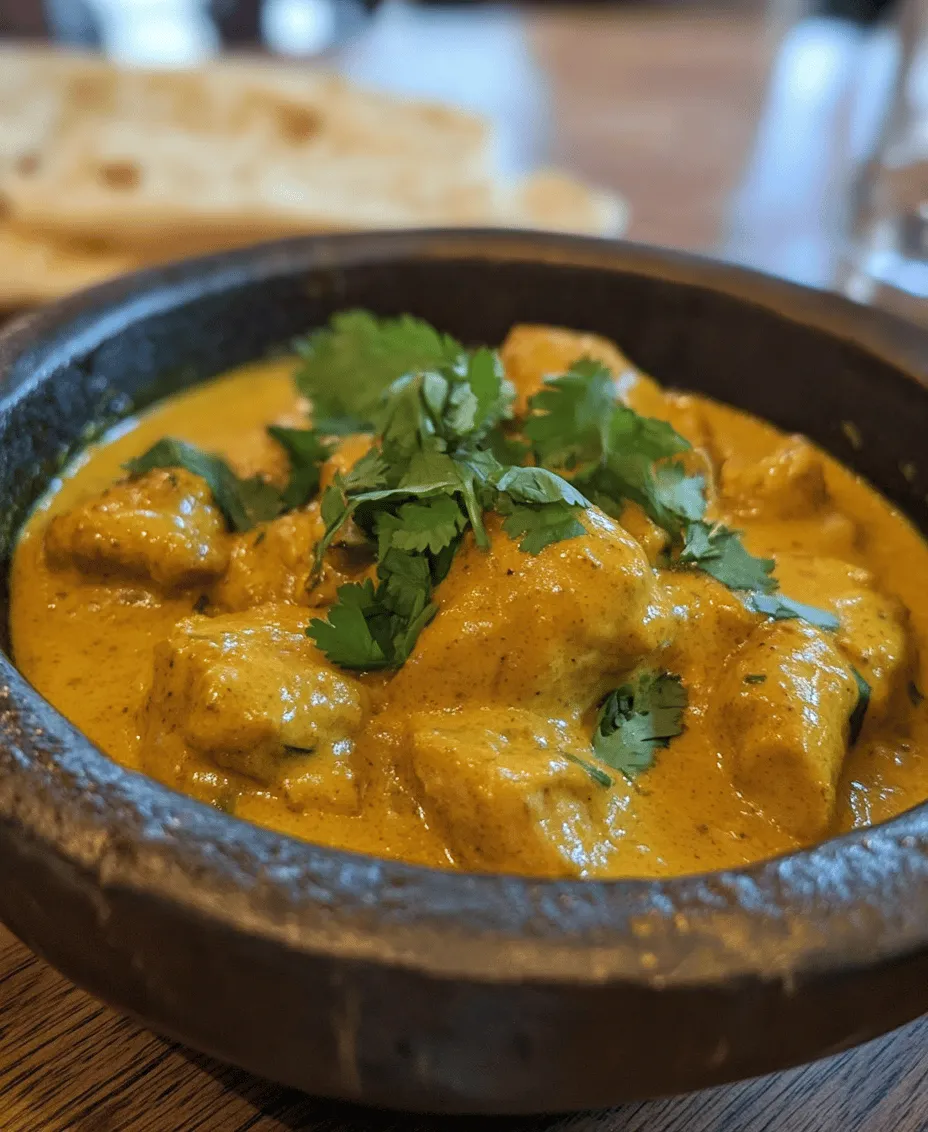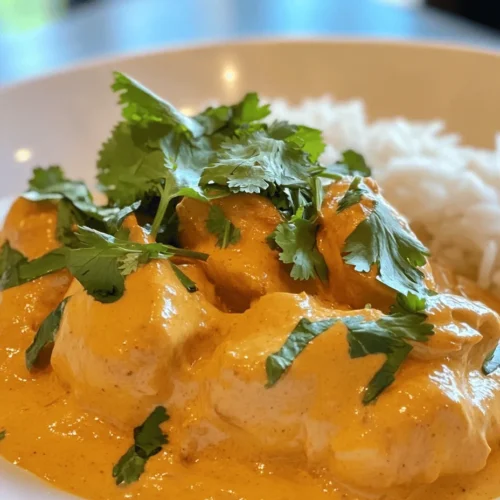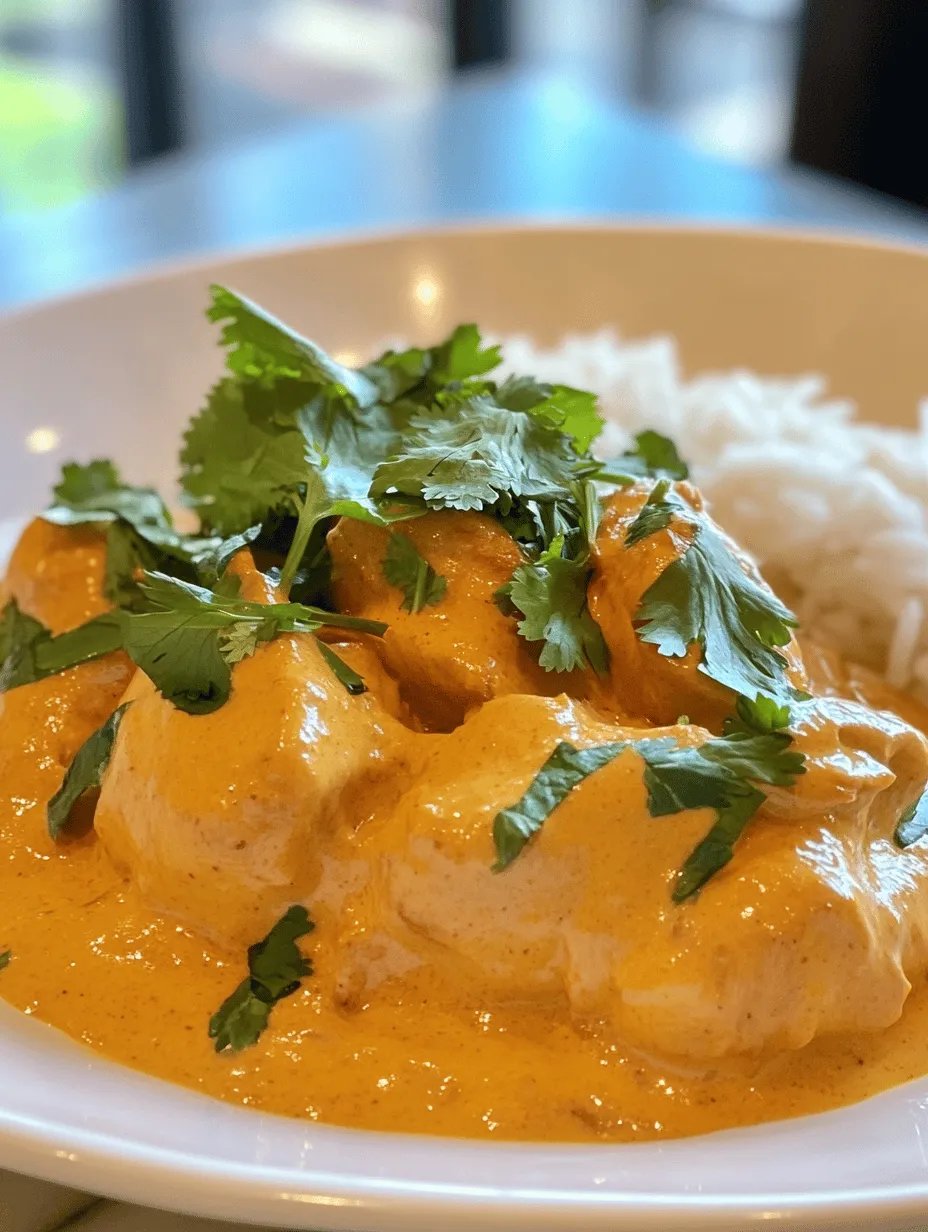Introduction
Kuku Paka is a delightful dish that has captured the hearts and taste buds of many, especially within the East African culinary landscape. Originating from the Swahili coast, this coconut chicken delicacy combines rich flavors and aromatic spices, making it a beloved meal among families and communities. The dish beautifully encapsulates the culinary fusion of African and Indian influences, showcasing how diverse cooking traditions can create something truly special.
The appeal of coconut chicken dishes is widespread, transcending cultural boundaries. The creamy richness of coconut milk pairs perfectly with tender chicken, resulting in a comforting and satisfying meal. As you delve into Kuku Paka, you’ll find that the combination of spices and fresh ingredients elevates its flavor profile, making it a dish that’s both indulgent and nutritious. Fresh ingredients are crucial in this recipe, ensuring that each bite bursts with flavor and authenticity.
Whether you’re planning a family dinner, a special occasion, or simply want to treat yourself, Kuku Paka is the perfect choice. This recipe promises to transport you to the sunny shores of East Africa with its vibrant flavors and inviting aroma. Join us as we explore the cultural significance, ingredients, and preparation steps of this delectable dish, setting the stage for a culinary adventure that you won’t soon forget.
Understanding Kuku Paka
Cultural Background
Kuku Paka is not just a meal; it’s a representation of the rich culinary traditions of the Swahili people, who inhabit the coastal regions of East Africa, including Kenya and Tanzania. The dish is often enjoyed during festive gatherings and family celebrations, highlighting its importance in communal dining practices. The name “Kuku Paka” itself translates to “chicken in coconut,” a fitting description of its primary components.
The dish reflects a unique fusion of African and Indian culinary practices. The Swahili coast has a long history of trade and cultural exchange with Indian merchants, resulting in a blend of flavors and cooking techniques. Kuku Paka showcases this fusion beautifully, with its use of coconut milk—a staple in both Indian and East African kitchens. The marriage of spices that are commonly found in Indian cuisine, such as curry powder and turmeric, with local ingredients creates a dish that is both familiar and exotic to those who encounter it.
Flavor Profile
What sets Kuku Paka apart is its unique flavor combination that tantalizes the palate. The dish is characterized by the creamy richness of coconut milk, which serves as a base for the chicken and infuses it with a subtle sweetness. The use of fresh herbs and spices adds depth and complexity, resulting in a harmonious balance of flavors.
As you savor Kuku Paka, you’ll notice the aromatic experience that unfolds with each bite. The fragrant blend of spices, including cumin, coriander, and turmeric, complements the tender chicken, creating a dish that is both comforting and invigorating. The heat from green chilies adds a gentle kick, while the freshness of cilantro or parsley provides a refreshing contrast. This combination of textures and flavors makes Kuku Paka a standout dish that captures the essence of its cultural roots.
Ingredients Breakdown
Main Ingredients
At the heart of Kuku Paka is chicken, which serves as the primary protein source. For the best results, skin-on chicken pieces are recommended. This choice not only enhances the flavor but allows for the skin to become deliciously crisp during cooking, adding an additional layer of texture to the dish. The chicken is usually marinated beforehand, allowing the spices to penetrate and infuse the meat, resulting in a more flavorful outcome.
Coconut milk is another essential ingredient in Kuku Paka. Not only does it contribute to the creamy texture of the dish, but it also offers a wealth of health benefits. Rich in medium-chain triglycerides (MCTs), coconut milk can provide a quick source of energy, support heart health, and even aid in weight management. Its natural sweetness and fat content create a rich and satisfying sauce that coats the chicken beautifully.
Aromatics and Spices
The foundation of flavor in Kuku Paka is built upon a variety of aromatics and spices. Onions, garlic, and ginger play a crucial role in creating a fragrant base that enhances the overall taste of the dish. The caramelization of onions adds sweetness, while garlic and ginger contribute warmth and depth. Fresh green chilies introduce a mild heat, allowing you to adjust the spice level according to your preference.
In addition to these aromatics, a selection of spices is integral to the dish’s flavor profile. Curry powder is a cornerstone of Kuku Paka, bringing a warm and earthy flavor that complements the chicken. Cumin adds a nutty, savory note, while coriander provides a citrusy brightness. Turmeric, known for its anti-inflammatory properties, not only contributes a vibrant yellow color but also adds a subtle earthiness to the dish. Each of these spices plays a distinct role in crafting the unique taste that Kuku Paka is known for.
Accompaniments
Kuku Paka is a versatile dish that pairs wonderfully with various accompaniments. Traditional serving options often include rice and flatbreads, both of which are excellent for soaking up the rich coconut sauce. Steamed basmati rice, with its fluffy texture and aromatic qualities, complements the flavors of the dish perfectly. Alternatively, you might opt for chapati or naan, which add a delightful chewiness and enhance the overall dining experience.
These accompaniments not only balance the richness of the Kuku Paka but also provide a satisfying base that brings the meal together. Whether you’re serving it for a special occasion or a cozy family dinner, the combination of Kuku Paka with rice or flatbreads creates a fulfilling and memorable meal.
Step-by-Step Guide to Preparing Kuku Paka
Preparation of Chicken
To begin making Kuku Paka, the first step involves preparing the chicken. Start by selecting high-quality skin-on chicken pieces, which can include thighs, drumsticks, or a whole cut-up chicken. The skin will help retain moisture during cooking and enhance the overall flavor profile.
Once you have your chicken, it’s essential to marinate it to infuse it with flavor. In a bowl, combine yogurt, garlic, ginger, and a selection of spices, including curry powder, cumin, and turmeric. The acidity in the yogurt will help tenderize the chicken while also allowing the spices to permeate the meat. Coat the chicken pieces thoroughly in the marinade, ensuring every bit is covered. Let it marinate for at least 30 minutes, though longer is preferable if time allows, as this will deepen the flavor.
After marinating, it’s time to cook the chicken. Heat a large skillet or pot over medium heat and add a drizzle of oil. Once the oil is hot, carefully place the marinated chicken pieces in the skillet, skin side down. Allow them to sear for about 5-7 minutes until the skin is golden brown and crispy. This step is crucial, as it develops a rich flavor that will enhance the overall dish.
Once the chicken is beautifully browned, remove it from the skillet and set it aside. This will help maintain its juiciness while you prepare the coconut sauce. In the same skillet, you’ll build the base for your Kuku Paka by sautéing onions, garlic, and ginger until fragrant.
By following these initial steps, you will set the stage for a delicious and aromatic Kuku Paka that will be the centerpiece of your meal. The careful preparation of the chicken and the development of the sauce are key to creating a dish that is both flavorful and satisfying. Prepare to embark on a culinary journey as you explore the next stages of this delightful recipe.

Importance of Marinating Chicken for Flavor Penetration
Marinating chicken is a crucial step in preparing Kuku Paka, as it allows the flavors to penetrate the meat deeply, enhancing the overall taste of the dish. The acidity of lemon juice not only tenderizes the chicken but also infuses it with a zesty brightness. When combined with a medley of spices, this marinade creates a flavorful base that elevates the dish to new heights. The longer you allow the chicken to marinate, the more pronounced these flavors will become. Ideally, marinate your chicken for at least 1 hour, though overnight in the refrigerator is best for maximum flavor absorption.
Detailed Instructions on Marinating with Lemon Juice and Spices
To prepare your marinade, gather the following ingredients:
– 2 tablespoons of lemon juice
– 1 teaspoon of ground cumin
– 1 teaspoon of ground coriander
– 1 teaspoon of paprika
– ½ teaspoon of turmeric
– Salt and pepper to taste
1. In a mixing bowl, combine the lemon juice, ground cumin, ground coriander, paprika, turmeric, salt, and pepper. Whisk until the ingredients are well blended.
2. Place the chicken pieces in the bowl, ensuring each piece is thoroughly coated in the marinade. Alternatively, you can place the chicken in a resealable plastic bag, pour the marinade over it, and massage it into the meat.
3. Cover the bowl with plastic wrap or seal the bag, and refrigerate for at least 1 hour, or preferably overnight. This will allow the spices to infuse the chicken, resulting in a robust flavor profile.
Cooking the Aromatics
A successful Kuku Paka begins with perfectly cooked aromatics, which lay the foundation for the dish’s flavor. The key components include onions, garlic, ginger, and green chilies.
Tips for Sautéing Onions to Achieve the Right Texture and Sweetness
1. Start by heating 2 tablespoons of oil (vegetable or coconut oil works well) in a large skillet or Dutch oven over medium heat.
2. Once the oil is hot, add 1 large finely chopped onion. Sauté the onions, stirring occasionally, for about 8-10 minutes until they become golden brown. This process caramelizes the natural sugars in the onions, adding sweetness and depth to the dish.
3. Avoid rushing this step; low and slow is the way to go. If the onions begin to stick, you can add a splash of water to deglaze the pan.
Importance of Cooking Garlic, Ginger, and Chilies to Release Their Essential Oils
Once the onions are properly caramelized, it’s time to add the garlic, ginger, and green chilies.
1. Add 4 minced garlic cloves and 1 tablespoon of grated fresh ginger to the skillet, stirring them into the onions.
2. Sauté for an additional 1-2 minutes until fragrant, taking care not to burn the garlic as it can become bitter.
3. Finally, add 1-2 finely chopped green chilies, adjusting the amount based on your heat preference. Cook for another 1 minute to allow the flavors to meld together.
Cooking the Chicken
Now that your aromatics are perfectly cooked and fragrant, it’s time to introduce the marinated chicken.
Instructions on Browning the Chicken for Depth of Flavor
1. Increase the heat to medium-high and add the marinated chicken pieces to the skillet. Make sure not to overcrowd the pan; you may need to do this in batches.
2. Sear the chicken for about 4-5 minutes on each side until golden brown. This browning process is essential as it develops a rich flavor that enhances the overall dish.
3. Once browned, remove the chicken from the skillet and set it aside on a plate.
The Technique of Stirring Spices to Coat Evenly and Enhance Aroma
1. After browning the chicken, lower the heat back to medium. In the same skillet, add an additional teaspoon of ground cumin and a teaspoon of coriander.
2. Stir the spices into the aromatic mixture for about 30 seconds to toast them lightly. This step will intensify their flavors and create a fragrant base for the sauce.
Creating the Coconut Sauce
The crowning glory of Kuku Paka is its luscious coconut sauce that ties all the flavors together.
Instructions on Combining Coconut Milk and Tomato Paste for a Rich Sauce
1. Pour in 1 can (400 ml) of coconut milk and 2 tablespoons of tomato paste into the skillet with the spices and aromatics. Stir well to combine.
2. Bring the mixture to a gentle simmer, allowing the tomato paste to dissolve completely and infuse the sauce with a rich, tangy flavor.
Explanation of Simmering and Its Benefits for Flavor Melding and Tenderness
1. Once the sauce is combined, return the browned chicken to the skillet, ensuring it is submerged in the coconut sauce.
2. Cover the skillet and reduce the heat to low. Allow the chicken to simmer gently for 25-30 minutes. This slow cooking process not only makes the chicken tender but also allows the flavors to meld beautifully, creating a harmonious dish.
Final Touches
As your Kuku Paka reaches its final stages, it’s essential to add those finishing touches that elevate the dish.
Importance of Adjusting Seasoning and Garnishing with Fresh Coriander
1. After simmering, taste the sauce and adjust the seasoning as necessary. You may want to add salt, pepper, or even a splash of lime juice for brightness.
2. Just before serving, sprinkle a generous handful of freshly chopped coriander over the dish. The bright herbal notes will balance the rich coconut sauce beautifully and add a vibrant touch.
Presentation Tips for Serving Kuku Paka Attractively
1. Serve the Kuku Paka in a large, shallow bowl, allowing the sauce to pool around the chicken.
2. Accompany it with a side of fluffy basmati rice or warm naan bread to soak up the delicious sauce.
3. For an added touch, garnish with extra coriander and a few lime wedges on the side for freshness.
Nutritional Benefits of Kuku Paka
Kuku Paka is not only a delight for the taste buds but also offers a variety of health benefits, making it a wholesome choice for meals.
Health Benefits of Ingredients
1. Chicken: A lean source of protein, chicken is essential for muscle repair and growth. It also provides B vitamins, particularly B6 and niacin, which are crucial for energy metabolism.
2. Coconut Milk: Rich in healthy fats, particularly medium-chain triglycerides (MCTs), coconut milk can provide a quick energy source. It also contains lauric acid, which has antimicrobial properties.
3. Spices: The spices used in Kuku Paka, such as turmeric and cumin, are known for their anti-inflammatory and antioxidant properties. These spices can boost immunity and support overall health.
4. Fresh Herbs: Coriander not only adds flavor but is also rich in vitamins A, C, and K, as well as essential minerals.
Balanced Meal
Kuku Paka can easily fit into a balanced diet. When paired with whole grains like brown rice or whole wheat flatbreads, it provides a well-rounded meal containing proteins, healthy fats, and carbohydrates. This combination ensures sustained energy levels and keeps you satisfied.
Conclusion
Making Kuku Paka is not just about preparing a meal; it’s an experience that fills your kitchen with wonderful aromas and brings people together around the table. The process of marinating, sautéing, simmering, and garnishing creates a dish that is both comforting and exquisite.
This coconut chicken delight showcases the versatility of flavors and ingredients, making it a potential family favorite. Feel free to experiment with variations, such as adding seasonal vegetables like bell peppers or zucchini, or adjusting spice levels to cater to your tastes.
Cooking is a joyful journey, and sharing traditional dishes like Kuku Paka enriches our lives and bonds us with our loved ones. So gather your ingredients, embrace the process, and enjoy the delightful adventure of bringing this delicious dish to life.



